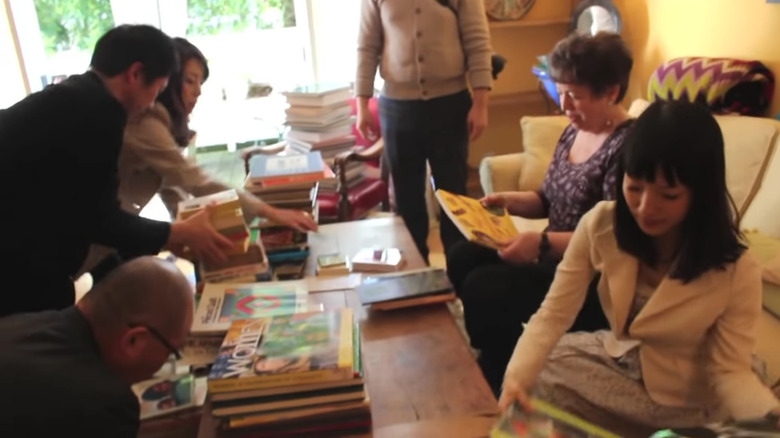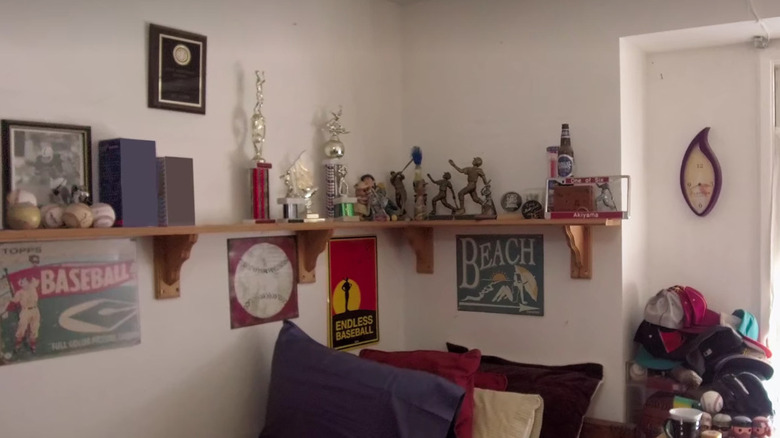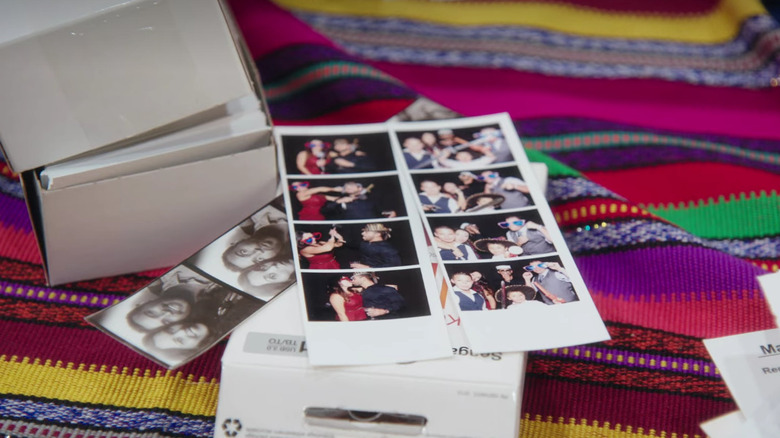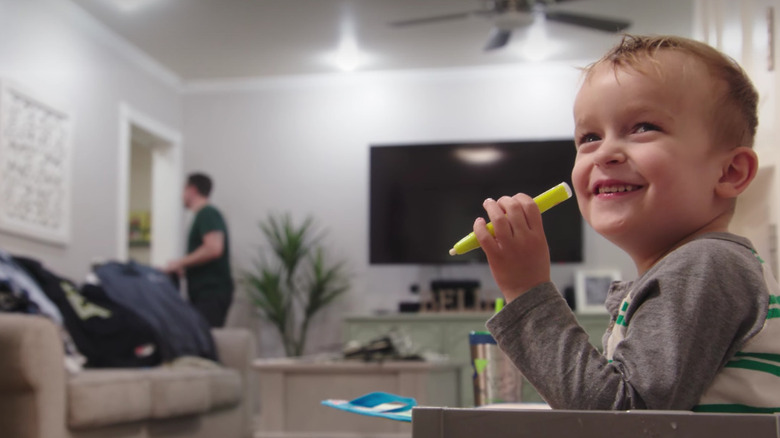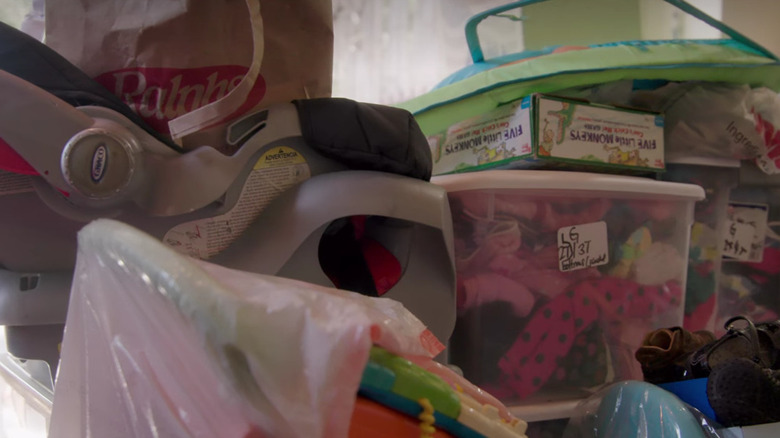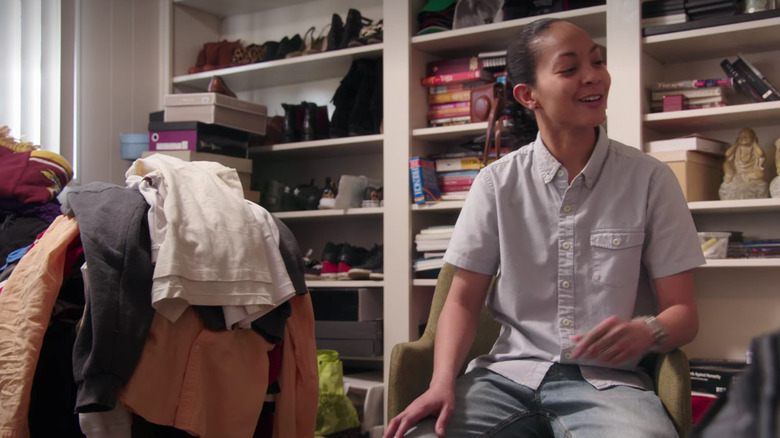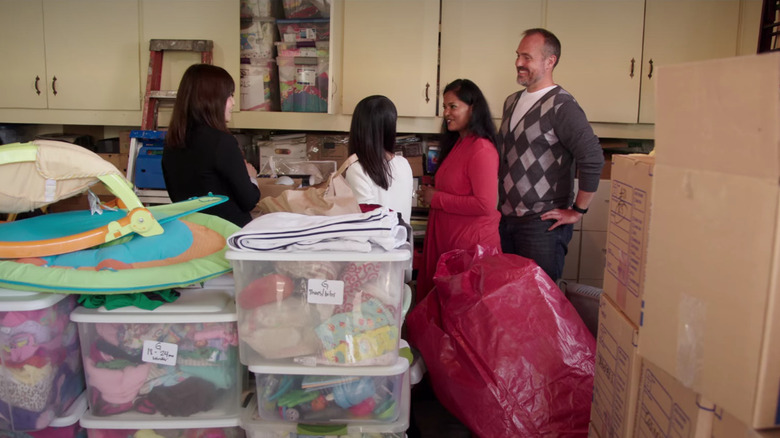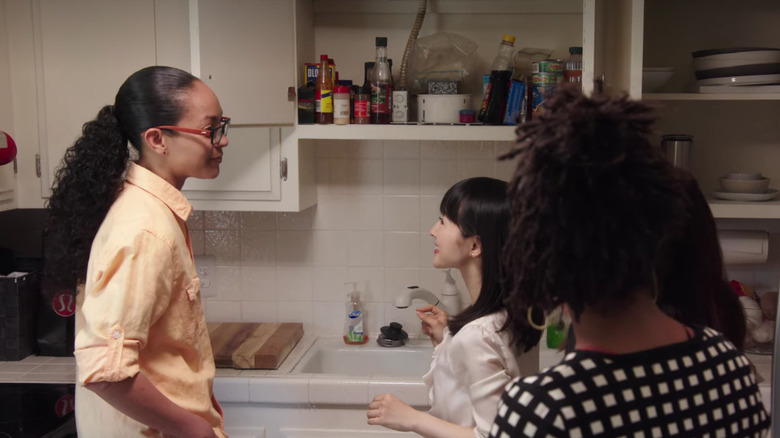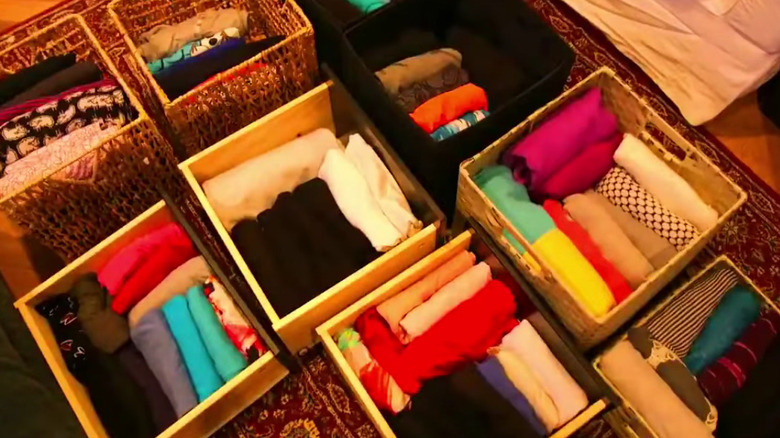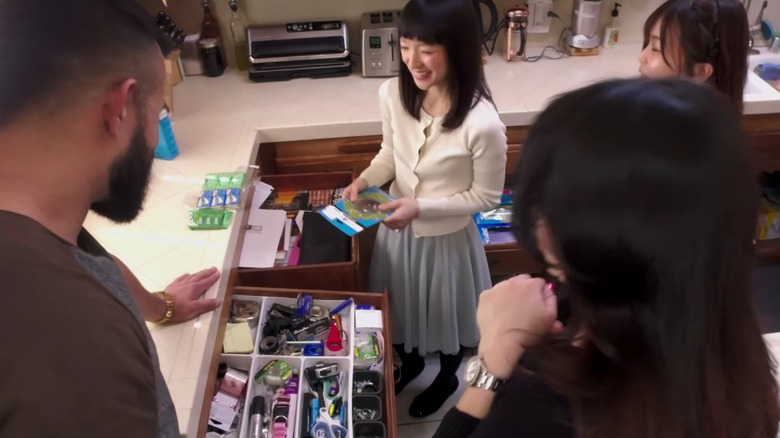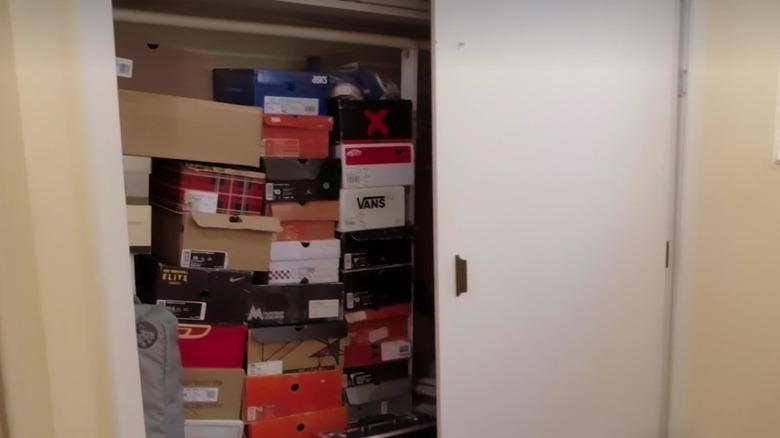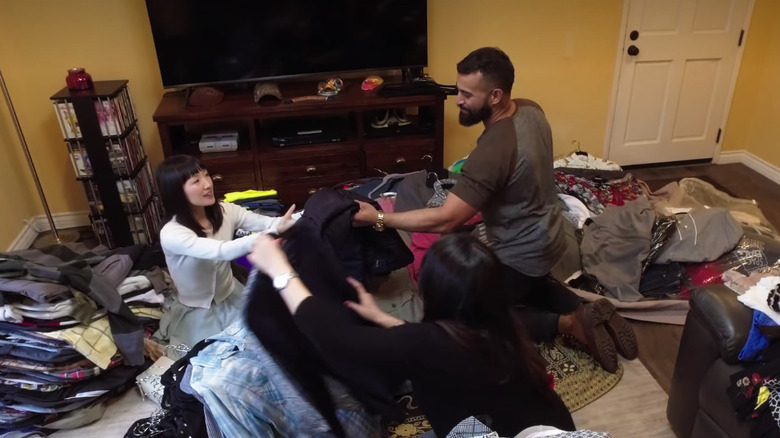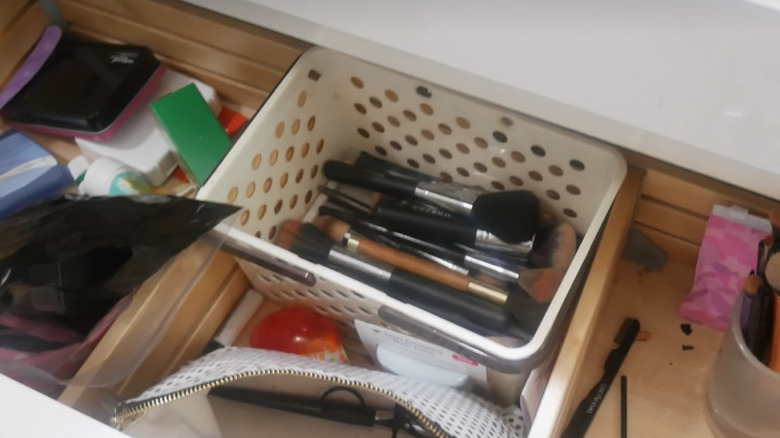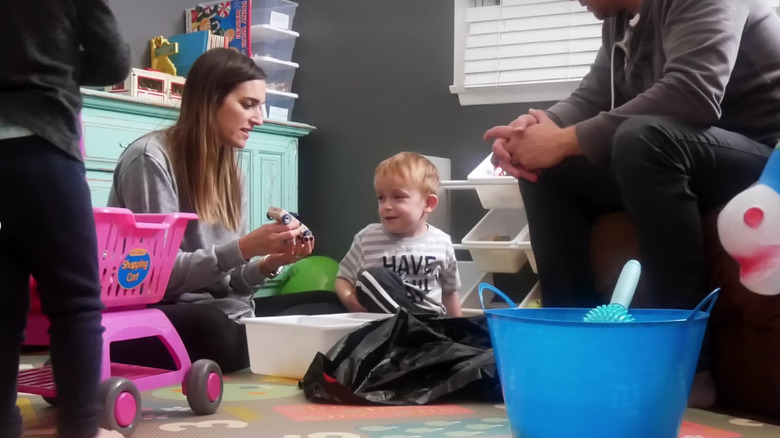Bad Advice Dished Out On Tidying Up With Marie Kondo
Japanese organization expert Marie Kondo has made a name for herself with her KonMari Method, which aims to help people clean and declutter their homes through a specific set of steps and instructions. Kondo's tidying method gained such popularity that Netflix released a reality series called "Tidying Up with Marie Kondo," documenting her helping various American households create a clutter-free and KonMari Method-approved environment. No doubt, Kondo — who had us all asking ourselves if our possessions "spark joy" — has given many useful tips that have genuinely helped people achieve their home organization goals. Yet, some of her advice has proven to be a little extreme, and even controversial, as per Apartment Therapy.
From some of her rigid approaches to cleaning to her cutthroat views on sentimentality, we can't say we agree with every bit of guidance Kondo has dished out. Here are a few examples of bad advice from the master organizer — let's see if you agree.
Keep only a small collection of books
This has been, without a doubt, Kondo's most controversial piece of advice ever given on the show. According to the Los Angeles Times, the internet went ablaze with reactions when Kondo told one woman to get rid of books she's already read and those she probably never will. Book lovers and literature enthusiasts absolutely did not agree with Kondo on this one, with Irish-Canadian author Anakana Schofield tweeting, "Do NOT listen to Marie Kondo or Konmari in relation to books. Fill your apartment & world with them."
She continued, "I don't give a s**te if you throw out your knickers and Tupperware, but the woman is very misguided about BOOKS. Every human needs a v extensive library, not clean, boring shelves." Apparently, Kondo limits her book collection to about 30, only holding onto the ones that spark joy, of course. Of all things to occupy shelves with, we think books are hardly a bad thing.
Get rid of items that belonged to family members who've passed away
No one is saying you should stockpile items that belonged to deceased loved ones, but there's also no denying that Kondo's advice is a little extreme. She believes that you shouldn't hold onto an object based on sentimental attachment alone — but rather, only if it actually brings you joy, as per Guardian. If it doesn't spark joy, Kondo advises people to say goodbye to the item and think of it as thanking it for its service and the purpose it played.
Heirlooms are important for keeping family history alive and even feeling connected to those who are no longer with us. Once again, you shouldn't keep so many items that belonged to loved ones that it borders on hoarding, but not everything that doesn't spark immense joy should be disposed of. Even if it is something that sits in a drawer for the majority of the time, when the time comes to bring it out and reminisce, it will surely be worth it.
Get rid of photographs
As Kathy Kozee of Midlife Rambler points out, Kondo's advice for decluttering and organizing photographs looks like this: Take all your photos out of frames, albums, bins, drawers, etc., and lay them out in one place so you can see them all at once. As if that isn't daunting enough, Kondo says to go through them all and get rid of those that are similar, from days you don't really remember, or simply moments that don't mean that much to you. So, essentially, keep only a handful of photos that you consider super important or that can act as representatives for an event.
But according to Kozee, it may be easy to make this decision when you're in the moment and not thinking about the future, but there will come a time where you'll find so much joy in having access to all those photographs. She points to numerous examples of when she returned to old stored photos to reminisce about the past, whether it was in honor of her uncle who was reaching the end of his life, or her daughter who was going off to college. Photographs are some of the most beautiful memories we can have.
Be selective with what you keep from your children
The same ruthless approach Kondo has towards getting rid of family photos and items from deceased loved ones, she also has for items related to your children. She believes that if you're going to keep something from them — such as birthday cards they made, school projects, their old clothes — you should be prepared to put it on display so it can bring you joy daily. She told Guardian, "If you bundle them into a drawer thinking, 'maybe some day I'll return to them,' then I doubt they spark joy in you, and they are taking energy away from other items that do spark joy for you."
No one is arguing that you should keep everything related to your child, but it's pretty extreme to ditch whatever you're not going to keep out. Just because you don't want to put your child's macaroni art project on display, doesn't mean you won't want to one day look back on it as a fond memory. There is joy in being able to return to these momentos, even if they're out of sight a majority of the time.
Avoid nostalgia in general
If you haven't been able to tell by now, Kondo is not a fan of nostalgia. The Organized Home reported she views keeping old things just for memento's sake as a way of living in the past, and that you should live only for yourself in your current state. While living in the moment is a great way to be, it can't always be that black and white.
Ditching (almost) everything related to your past or people who are no longer part of your life almost feels like an unhealthy coping mechanism. It should be a balance — don't keep a bin full of love letters from ex-partners, but don't wipe all memory of your past. Sure, objects aren't the only means of maintaining a memory close to your heart, but these moments or people can also slip away if you're not reminded of them. Plus, there may be something that would be nice to pass down to someone one day.
Don't clean in front of other people
To add more rules and restrictions to the mix, Kondo says you shouldn't clean with another person because you risk them weighing in on your decisions on what to keep and what to toss, as per Homes & Gardens. She especially stresses this in relation to family members. While we all can respect the judgment of not having someone around who you already know will hover over your shoulder and give their unwelcome option, sometimes it can be super helpful to have someone else involved.
Cleaning and decluttering — especially to the extent that Kondo recommends — can be quite a daunting task, so having another set of hands helping move the process along could be a game-changer. They may also be able to offer encouragement or a realistic perspective, especially if you're someone who usually has trouble getting rid of things. As long as the other person is actually helpful, it's hardly bad to have them around.
Don't rely on storage space
As we're sure you can imagine, Kondo doesn't view storage space quite like most of us probably do. Whereas ample storage space may be one of the biggest selling points when looking at a home, Kondo sees it as a potential to accumulate more clutter. She told Homes & Gardens, "Putting things away creates the illusion that the clutter problem has been solved, but sooner or later, all the storage units are full, the room once again overflows with things, and some new and 'easy' storage method becomes necessary, creating a negative spiral." She continues, "We need to exercise self-control and resist storing our belongings until we have finished identifying what we really want and need to keep."
The thing is, having places to store things does help reduce clutter and make your living environment more pleasant. There are things you need to keep that can't stay out, so isn't it better to have them neatly stored away?
Decant household products and food items
In a process that Kondo calls decanting, she suggests putting household products in new, brand-less containers. For example, transfer hand soap to pretty glass dispensers, or put dry food items — like cereal or rice — in clear storage containers, as per Livabl. This will prevent you from being bombarded with attention-grabbing brand names and clashing colors, making your environment appear neater and generally more aesthetically pleasing.
While all that may be true, this isn't the most practical advice. Not everyone has the luxury of buying additional items when the original products already come in usable containers of their own. This piece of advice seems unnecessary and not fully aligned with what the core motivation of decluttering your house should be. If this is something you like to do, then more power to you — but it adds an element of pressure and perfection that many people may not find helpful. Don't worry; we have no judgment if you want to keep your cereal in its original box.
Tidy by category, not location
Rather than tidying by room or a specific location in your house, Kondo says you should clean by category. And to go one step further, those categories have a specific order, but we'll talk more about that later. According to Kondo's website, when you tackle a category, you should take out those items from all areas of your house, wherever they may be. In her opinion, when you tidy by location (for example, your bedroom or the hall closet), you end up encountering the same types of items over and over again, and you may not fully realize how much you actually own.
This is a pretty rigid piece of advice that has the potential to derail people. Can you imagine taking out all miscellaneous items from your entire house? This would be one time that we'd certainly not envy those who live in mega-mansions. We can understand the thought behind this, but that doesn't mean it's necessarily good advice.
Tidy everything at once
Further, Kondo says you shouldn't tidy in stages, but rather set aside time to clean and declutter your entire home in one go in what she refers to as a "special event," as per The Spruce. She warns that if you declutter bits at a time, you're more likely to get distracted and will probably end up holding onto more items than you actually need.
This method could work in an ideal world, but it's not the most realistic approach. Not everyone can set aside a full day — or multiple days — to clean. For some of us, even finding a few free hours may be a challenge. Plus, if you already struggle with cleaning and decluttering, then using Kondo's method may be quite intimidating. In reality, some cleaning is better than no cleaning, so if you can only clean your bedroom or bathroom one weekend, do the best you can and tackle the remainder when you have time.
Don't keep things at your parents' house
While we're sure many parents wouldn't speak up against Kondo on this one, it doesn't mean it's her best piece of advice. DIY Passion reported that the organization queen warns against leaving your belongings in storage at your parents' house because it's not really solving the problem. Instead, it's transferring it to someone else. It makes sense that you'd want to avoid dumping your stuff with mom and dad, but things can't always be that black and white.
For example, some of us may have more limited space in our current living situations and could use the assistance of a larger storage area. Just because you don't have room for your skis in your tiny city apartment doesn't mean you need to get rid of them — especially if your parents have space (and are willing) to store them in their garage. We could all be so lucky to have parents that can offer this kind of help.
Tidy in a very specific order
Back to that whole tidying by category and not location thing — Kondo has a specific order to these categories that she believes everyone should follow. According to her website, the order goes as follows: clothes, books, papers, komono (miscellaneous items), and then sentimental items. She claims that following this order has proven to be the most efficient and effective. This is the order she views as working from easiest to most difficult. Yet, there are issues with a one-size-fits-all approach because we do not all work the same way.
This type of rigidity would certainly pose a challenge for those with conditions like ADHD. The tasks of cleaning, decluttering, and organizing may be daunting enough on their own, so having someone go through their entire house to gather something like papers sounds like a recipe for disaster. The right approach is the one that works best for you, so if that means tackling one corner of a room at a time, then so be it.
Don't keep sample size toiletry items
Kondo says to dispose of any sample size toiletry items because they cause clutter and take up space. While we can support this from the angle of not taking home every mini bottle of lotion you come across in a hotel room, her advice doesn't take into account that sometimes these small-size products can be quite useful — especially in relation to carry-on liquid restrictions when flying.
The better question to ask yourself when cleaning is if it's a product you'll actually use. Go through all your sample size toiletries and first throw out any that are expired (you know there will be a ton). Then, take inventory of what is still usable and be honest with yourself about what you'd take on a trip. Now you'll have an organized collection of toiletries ready to go the next time you pack your carry-on.
Does it spark joy?
The infamous question — does it spark joy? Basing your decision on what to keep on this question alone is nice in theory, but it's not always the most relevant question to ask. Not everything worth owning is going to be related to feelings of joy. Some stuff is simply practical or necessary.
Instead, ask yourself how often you've used or worn the item in the last few months. The Minimalists recommend the 90/90 rule: Have you used it in the last 90 days? And will you use it in the next 90 days? If the answer to these questions is no, it's time to get rid of it. Another thing to focus on when decluttering is inventory. Do you own multiple nearly identical black sweaters? How about multiple copies of the same book? We think the answer is pretty clear here. Having a house full of joyful items sounds amazing, but it doesn't always get to the bottom of figuring out what you really need.

